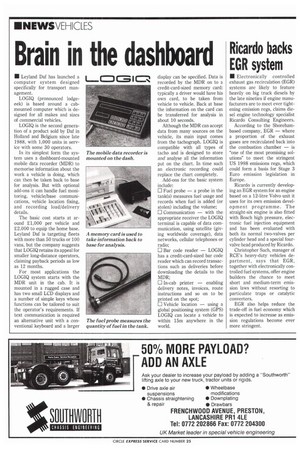Brain in the dashboard
Page 10

If you've noticed an error in this article please click here to report it so we can fix it.
• Leyland Daf has launched a computer system designed specifically for transport management.
LOGIQ (pronounced lodgeeek) is based around a cabmounted computer which is designed for all makes and sizes of commercial vehicles.
LOGIQ is the second generation of a product sold by Daf in Holland and Belgium since late 1988, with 1,000 units in service with some 30 operators.
In its simplest form the system uses a dashboard-mounted mobile data recorder (MDR) to memorise information about the work a vehicle is doing, which can then be taken back to base for analysis. But with optional add-ons it can handle fuel monitoring, vehicle/base communications, vehicle location fixing, and recording load/delivery details.
The basic cost starts at around £1,000 per vehicle and £2,000 to equip the home base_ Leyland Daf is targeting fleets with more than 50 trucks or 100 vans, but the company suggests that LOGIQ retains its appeal for smaller long-distance operators, claiming payback periods as low as 12 months.
For most applications the LOGIQ system starts with the MDR unit in the cab. It is mounted in a rugged case and has two small LCD displays and a number of simple keys whose functions can be tailored to suit the operator's requirements. If text communication is required an alternative unit with a conventional keyboard and a larger display can be specified. Data is recorded by the MDR on to a credit-card-sized memory card: typically a driver would have his own card, to be taken from vehicle to vehicle. Back at base the information on the card can be transferred for analysis in about 10 seconds.
Although the MDR can accept data from many sources on the vehicle, its main input comes from the tachograph. LOGIQ is compatible with all types of tacho and is designed to store and analyse all the information put on the chart. In time such an electronic recording could replace the chart completely.
Add-ons for the basic system include:
Li Fuel probe — a probe in the tank(s) measures fuel usage and records when fuel is added (or stolen) including the volume; LI Communication — with the appropriate receiver the LOGIQ terminal is capable of data communication, using satellite (giving worldwide coverage), data networks, cellular telephones or radio; CI Bar code reader — LOGIQ has a credit-card-sized bar code reader which can record transactions such as deliveries before downloading the details to the MDR; Li In-cab printer — enabling delivery notes, invoices, route instructions and so on to be printed on the spot;
El Vehicle location — using a global positioning system (GPS) LOGIQ can locate a vehicle to within 15m anywhere in the world.




















































































